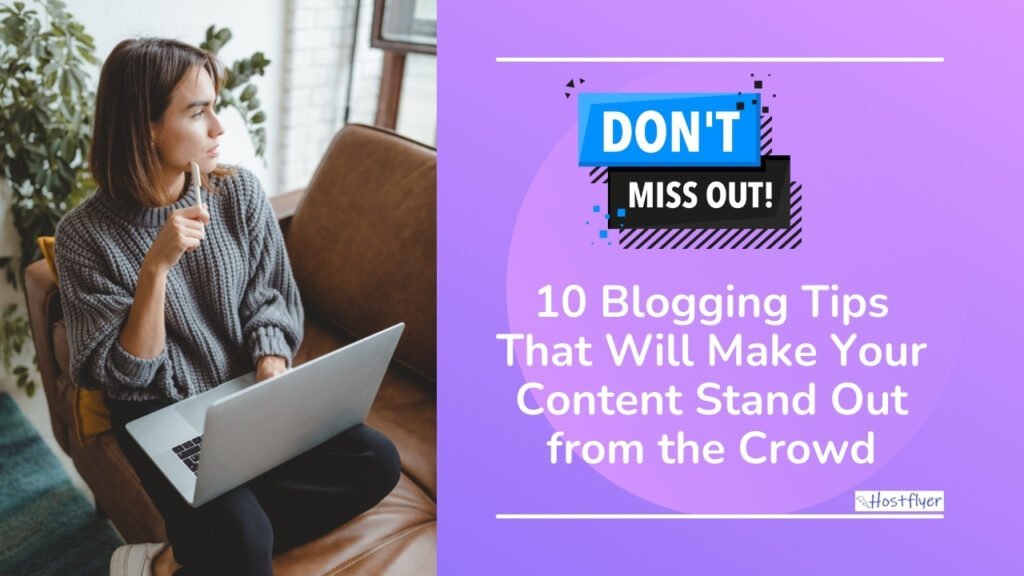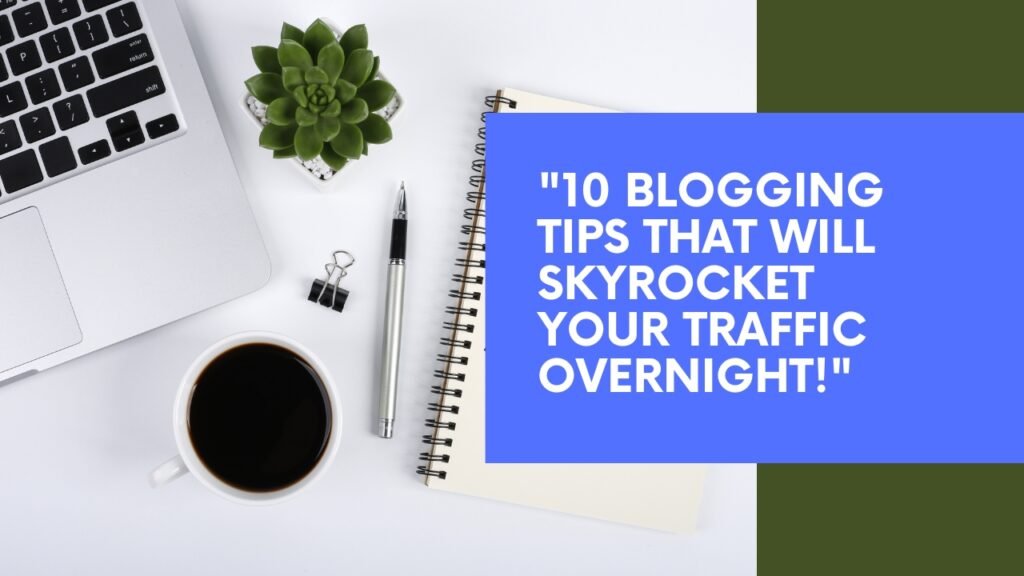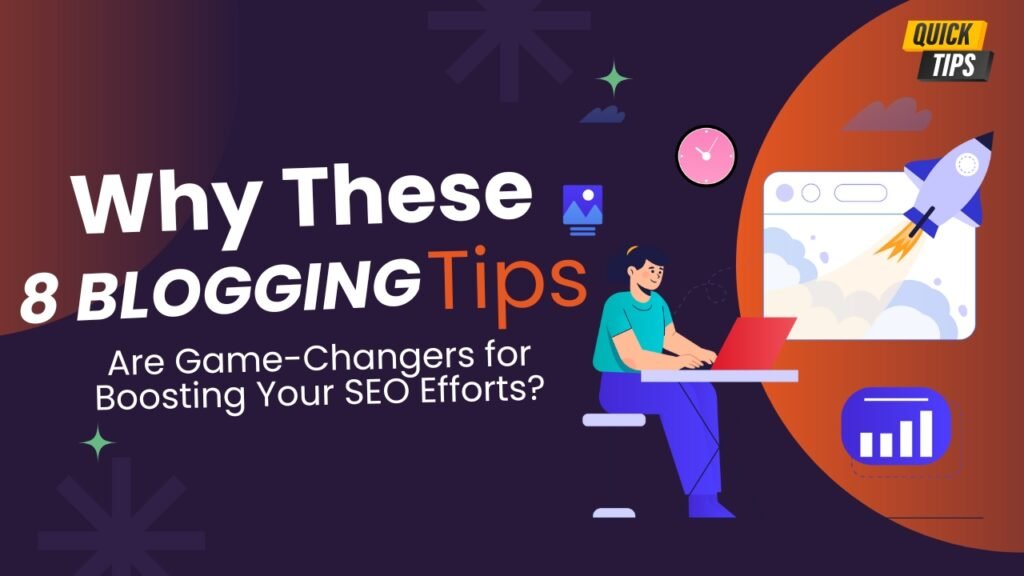Don’t Miss Out: 10 Blogging Tips That Will Make Your Content Stand Out from the Crowd
Blogging is a dynamic field, constantly evolving with trends and technological advancements. For bloggers, standing out in this crowded space requires more than just good writing skills. It demands strategic planning, creativity, and a thorough understanding of SEO. This article delves into 10 essential blogging tips that can help your content shine and attract more readers.
Understanding Your Audience

One of the foundational steps to successful blogging is understanding your audience. Knowing who your readers are, what they are interested in, and what problems they need solutions for is crucial. Conducting thorough audience research allows you to create content that resonates with them, increasing engagement and loyalty.
Demographics and Psychographics
Understanding demographics such as age, gender, location, and occupation helps in tailoring your content. However, delving into psychographics—interests, values, and lifestyles—provides deeper insights into your audience’s motivations. Tools like Google Analytics, social media insights, and surveys can provide valuable data.
Creating Reader Personas
Creating detailed reader personas based on your research can guide your content strategy. These personas represent different segments of your audience and help you create targeted content. For example, if one of your personas is a young professional interested in career growth, your content can focus on productivity tips, industry trends, and skill development.
Analyzing Audience Feedback
Regularly analyzing audience feedback through comments, emails, and social media interactions can provide direct insights into their preferences and concerns. Implementing feedback not only improves your content but also shows your readers that you value their input, fostering a stronger connection.
Crafting Compelling Headlines

Your headline is the first thing readers see, and it significantly impacts their decision to click on and read your content. Crafting compelling headlines is an art that involves creativity and understanding of SEO.
The Power of Emotional Triggers
Headlines that evoke emotions such as curiosity, excitement, or urgency tend to perform better. Using words that trigger emotions can make your headlines more clickable. For example, “Unbelievable Tips to Skyrocket Your Blog Traffic” is likely to attract more attention than a simple “Blog Traffic Tips.”
Incorporating Keywords
Incorporating relevant keywords in your headlines not only helps with SEO but also makes it clear to readers what your content is about. However, it’s essential to balance keyword inclusion with readability. A headline like “10 Proven Blogging Tips to Increase Traffic” effectively includes keywords without compromising on clarity.
Using Numbers and Lists
Headlines with numbers and lists often perform well because they promise specific, actionable information. Readers are more likely to click on a headline like “7 Ways to Improve Your Blog’s SEO” because they know exactly what to expect.
Incorporating Visual Elements

Visual elements are crucial for making your blog posts more engaging and easier to digest. They break up text, illustrate points, and can significantly improve the reader’s experience.
High-Quality Images
Using high-quality, relevant images can make your blog posts more visually appealing. Images should complement your content and provide additional context or information. Stock photo sites and graphic design tools like Canva can help you source or create engaging visuals.
Infographics and Data Visualization
Infographics and data visualizations are excellent for presenting complex information in an easy-to-understand format. Tools like Piktochart and Infogram can help you create professional-looking infographics that enhance your content.
Videos and Interactive Elements
Incorporating videos and interactive elements like quizzes and polls can increase engagement and time spent on your page. Videos, in particular, can explain concepts in a more dynamic way than text and are highly shareable on social media.
Utilizing SEO Best Practices

SEO is critical for driving organic traffic to your blog. Implementing best practices ensures that your content is discoverable and ranks well on search engines.
Keyword Research and Optimization
Conduct thorough keyword research using tools like Google Keyword Planner, Ahrefs, or SEMrush. Identify keywords that have a good balance of search volume and competition. Optimize your content by including these keywords in strategic places such as the title, headings, meta descriptions, and throughout the text.
On-Page SEO Techniques
On-page SEO involves optimizing individual web pages to rank higher and earn more relevant traffic. Techniques include using descriptive URLs, optimizing images with alt text, using internal linking to improve navigation, and ensuring your site is mobile-friendly.
Technical SEO
Technical SEO focuses on improving the backend structure of your site. This includes improving site speed, ensuring a secure connection (HTTPS), and making sure your site is crawlable by search engines. Regularly checking and fixing broken links and using a sitemap can also enhance your site’s SEO.
Must Read: 10 WP Plugins You Can’t Live Without – Ultimate Review!
Consistency is Key
Consistency in blogging is crucial for building and maintaining an audience. It involves not only publishing content regularly but also maintaining a consistent voice and style.
Setting a Publishing Schedule
A consistent publishing schedule helps build anticipation and loyalty among your readers. Whether you publish weekly, bi-weekly, or monthly, sticking to a schedule ensures your audience knows when to expect new content. Tools like editorial calendars can help you plan and organize your content.
Maintaining a Consistent Voice
Your writing style and voice should be consistent across all your posts. This helps build your brand identity and makes your content more recognizable. Whether your tone is formal, casual, humorous, or authoritative, consistency is key.
Quality Over Quantity
While it’s important to publish regularly, quality should never be compromised. High-quality content that provides value to your readers will always perform better than frequent, low-quality posts. Focus on creating in-depth, well-researched articles that address your audience’s needs and interests.
Engaging with Your Readers
Engagement is a two-way street. Encouraging readers to interact with your content can build a community around your blog and foster loyalty.
Responding to Comments
Taking the time to respond to comments shows your readers that you value their input. Engaging in meaningful conversations can also provide additional insights and ideas for future content.
Encouraging Social Sharing
Include social sharing buttons on your blog posts to make it easy for readers to share your content on their networks. Encouraging sharing not only increases your reach but also brings in new readers who might be interested in your content.
Hosting Webinars and Q&A Sessions
Hosting webinars and Q&A sessions can provide a more interactive way for readers to engage with you. These sessions allow you to address specific questions and provide deeper insights into your content, further strengthening your relationship with your audience.
Leveraging Social Media

Social media platforms are powerful tools for promoting your blog and reaching a broader audience. Each platform has its own unique features and audience, and leveraging them effectively can boost your blog’s visibility.
Choosing the Right Platforms
Not all social media platforms are created equal. Identify where your audience spends most of their time and focus your efforts there. For example, if your audience is primarily professionals, LinkedIn might be more effective than Instagram.
Creating Shareable Content
Content that is easily shareable on social media can increase your blog’s reach. Infographics, short videos, and engaging visuals are often shared more frequently. Additionally, writing compelling captions and using relevant hashtags can increase your content’s visibility.
Engaging with Your Social Media Audience
Regularly engaging with your followers on social media can drive traffic to your blog. Responding to comments, participating in conversations, and sharing content from other creators can build a community around your brand and increase your blog’s exposure.
Collaborating with Influencers
Collaborating with influencers in your niche can amplify your reach and bring new readers to your blog. Influencers have established audiences who trust their recommendations, making influencer partnerships valuable for growth.
Identifying the Right Influencers
Identify influencers whose audience aligns with your target demographic. Tools like BuzzSumo and FollowerWonk can help you find influencers based on relevance and engagement. Building genuine relationships with influencers can lead to more authentic and effective collaborations.
Types of Collaborations
There are various ways to collaborate with influencers, including guest blogging, social media takeovers, sponsored posts, and joint webinars. Choose the type of collaboration that best suits your goals and aligns with the influencer’s style.
Measuring Collaboration Success
Track the performance of your collaborations to understand their impact. Metrics such as increased traffic, social media engagement, and new followers can indicate the success of your influencer partnerships. Use this data to refine your future collaboration strategies.
Analyzing and Adapting

Continuous analysis and adaptation are crucial for the long-term success of your blog. Regularly reviewing your performance metrics helps you understand what’s working and what needs improvement.
Using Analytics Tools
Tools like Google Analytics, Ahrefs, and SEMrush can provide detailed insights into your blog’s performance. Analyzing metrics such as page views, bounce rate, and average session duration can help you understand your audience’s behavior and preferences.
Adapting Your Strategy
Based on your analysis, adapt your content strategy to better meet your audience’s needs. If certain types of content perform better, focus on creating more of those. Similarly, if some topics or formats are underperforming, consider
adjusting your approach or experimenting with new ideas.
Staying Updated with Trends
The blogging landscape is constantly evolving. Staying updated with the latest trends and best practices can help you stay ahead of the competition. Regularly reading industry blogs, attending webinars, and participating in forums can keep you informed about new strategies and tools.
Monetizing Your Blog
Monetizing your blog can turn your passion into a sustainable income source. There are various monetization strategies, each with its benefits and challenges.
Advertising and Sponsorships
Advertising through platforms like Google AdSense and direct sponsorships from brands can generate revenue. Sponsored content, where you collaborate with brands to create posts, can also be lucrative if done authentically.
Affiliate Marketing
Affiliate marketing involves promoting products or services and earning a commission for every sale made through your referral link. Choosing products that align with your audience’s interests ensures higher conversion rates and credibility.
Selling Products and Services
Offering products and services such as e-books, online courses, consulting, or merchandise can provide additional income streams. These offerings should provide value to your audience and align with your blog’s niche.
FAQs
How do I identify my target audience for blogging?
Conduct thorough research using tools like Google Analytics, surveys, and social media insights to understand the demographics and psychographics of your audience. Creating detailed reader personas based on this data can guide your content strategy.
What are some effective ways to craft compelling headlines?
Use emotional triggers, incorporate relevant keywords, and include numbers or lists in your headlines. This makes them more engaging and clickable.
How can I make my blog posts more visually appealing?
Incorporate high-quality images, infographics, and videos. These elements break up the text and make your content more engaging and easier to understand.
What are the best practices for SEO in blogging?
Conduct thorough keyword research, optimize your content with on-page SEO techniques, and focus on technical SEO. This includes using descriptive URLs, optimizing images, and ensuring your site is mobile-friendly and fast-loading.
How can I engage with my readers effectively?
Respond to comments, encourage social sharing, and host interactive sessions like webinars and Q&As. Engaging with your audience fosters a stronger connection and loyalty.
Which social media platforms should I use to promote my blog?
Choose platforms where your target audience spends most of their time. Focus on creating shareable content and engaging with your followers to drive traffic to your blog.
How can I collaborate with influencers?
Identify influencers whose audience aligns with your target demographic. Build genuine relationships and choose collaboration types like guest blogging, social media takeovers, and sponsored posts.
How do I analyze my blog’s performance?
Use analytics tools like Google Analytics to track metrics such as page views, bounce rate, and average session duration. Regularly review and adapt your content strategy based on these insights.
What are some effective monetization strategies for blogs?
Monetize through advertising, sponsorships, affiliate marketing, and selling products or services. Choose strategies that align with your blog’s niche and provide value to your audience.



